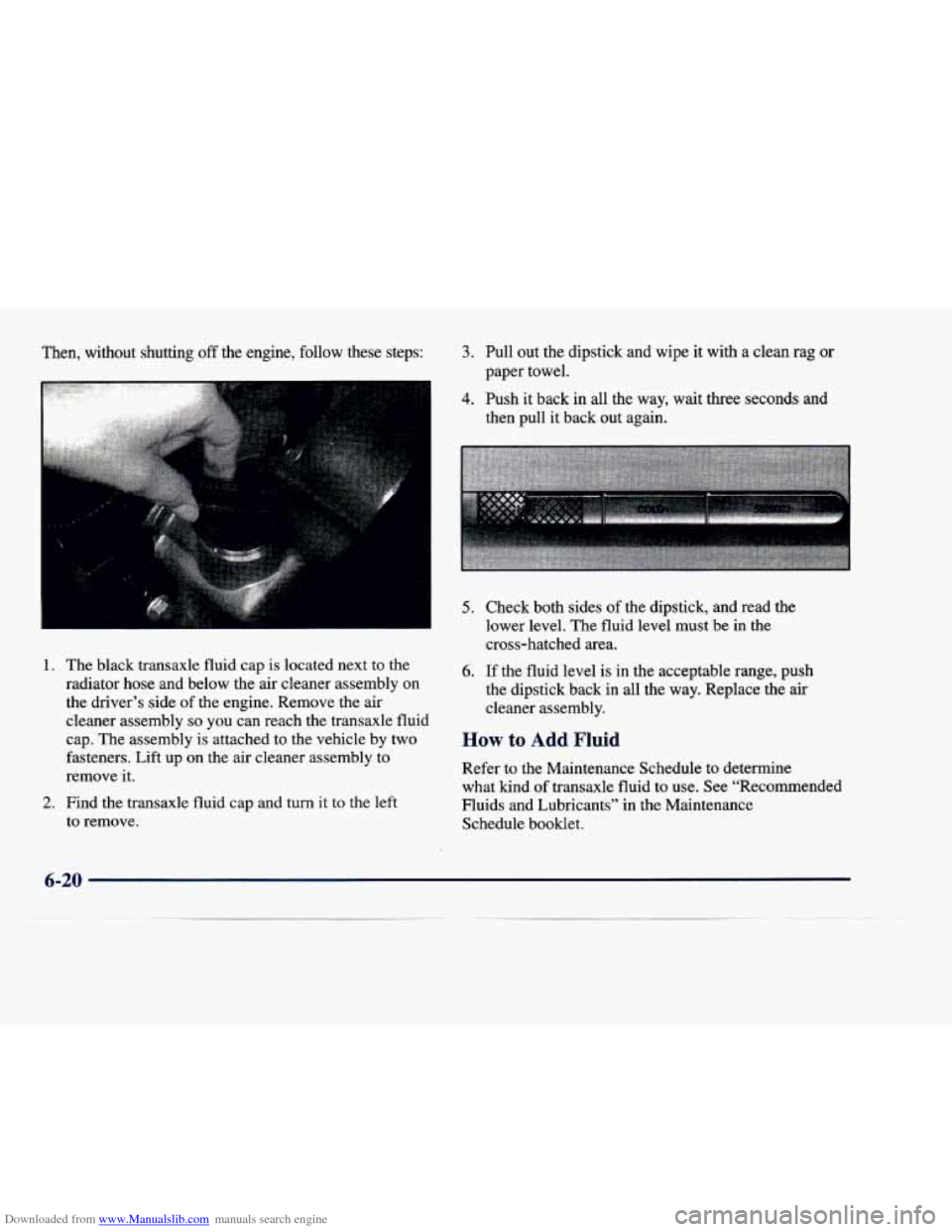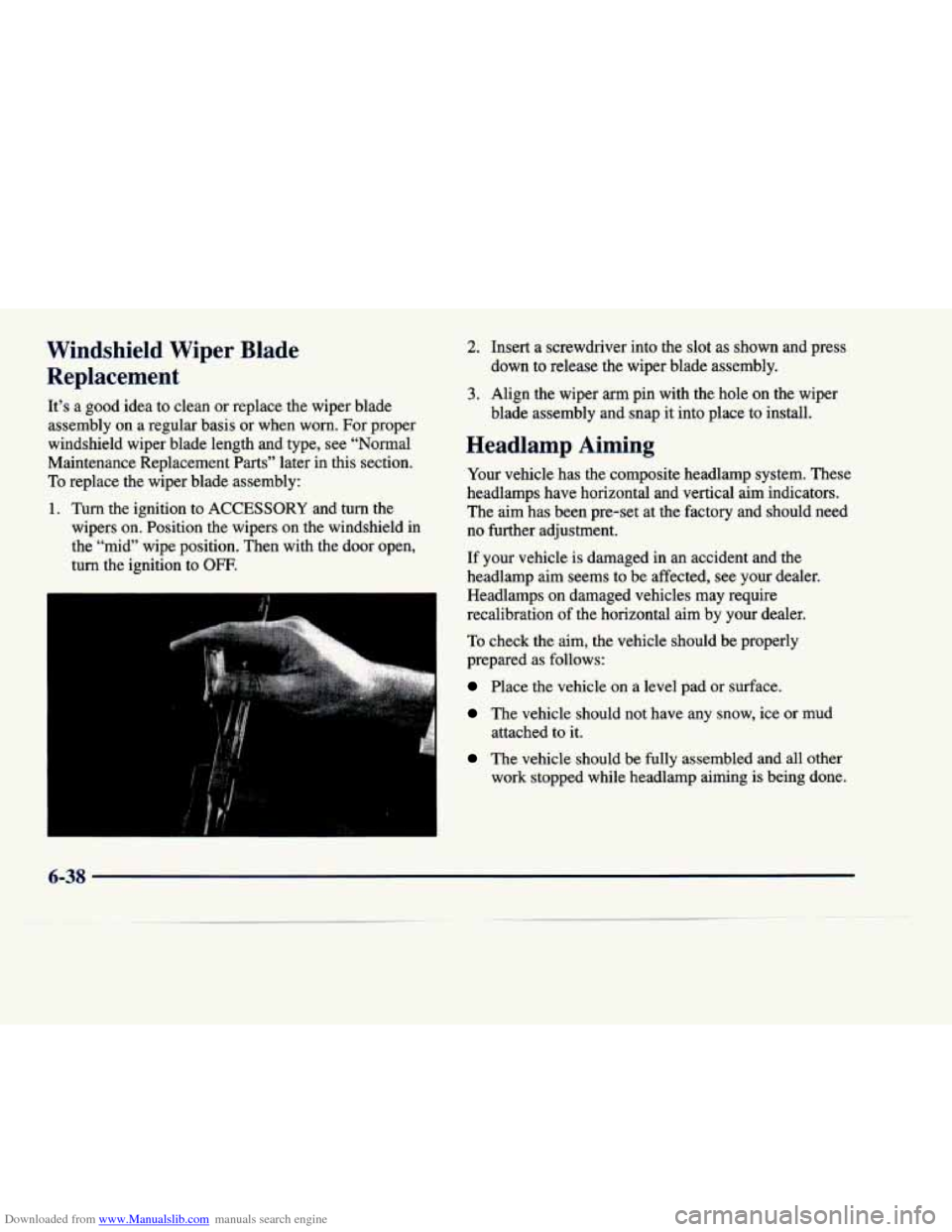1998 CADILLAC DEVILLE maintenance
[x] Cancel search: maintenancePage 304 of 386

Downloaded from www.Manualslib.com manuals search engine 6. Take out the air cleaner filter and remove any
loose debris that may be found laying in the air
cleaner base.
7. Install a new air filter element. See “Normal
Maintenance Replacement
Parts” in the Index. Follow these steps to reinstall the air cleaner assembly:
1.
2.
3.
4.
5.
Slide
the air cleaner lid into the slots in the front
edge of
the air cleaner base.
Pivot the air cleaner cover and the air duct assembly
downward. Make sure that both latches
are secure
and fully engaged.
Reinstall the clean air duct over the mass airflow sensor. Make sure that the duct is secure around the
entire outer edge
of the sensor.
Tighten the air duct clamp.
Reconnect the IAT sensor.
Refer
to the Maintenance Schedule to determine when to
replace the air filter.
See “Scheduled Maintenance Services” in the
Maintenance Schedule booklet.
Page 305 of 386

Downloaded from www.Manualslib.com manuals search engine Automatic Transaxle Fluid
Operating the engine with the air cleaner off can
cause you or others to be burned, The air cleaner
not only cleans the air, it stops flame if the engine
backfires.
If it isn’t there, and the engine
backfires, you could be burned, Don’t drive with
it
off, and be careful working on the engine with
the air cleaner
off.
NOTICE:
If the air cleaner is off, a backfke can cause a
damaging engine fire. And, dirt can easily get
into your engine, which will damage it. Always
have the air cleaner in place when you’re driving.
When to Check and Change
A good time to check your automatic transaxle fluid
level is when the engine oil is changed.
Change both the fluid and filter every
50,000 miles
(83 000 km) if the vehicle is mainly driven under
one or more of these conditions:
0 In heavy city traffic where the outside temperature
0 In hilly or mountainous terrain. regularly reaches
90°F (32°C) or higher.
0 When doing frequent trailer towing.
0 Uses such as found in taxi, police or delivery service.
0 Use such as limousine service.
If you do not use your vehicle under any of these
conditions, the fluid and filter do not require change
until
the message CHANGE TRANS FLUID appears
on the Driver Information Center.
See “Scheduled Maintenance Services” in the
Maintenance Schedule booklet.
6-18
Page 307 of 386

Downloaded from www.Manualslib.com manuals search engine Then, without shutting off the engine, follow these steps:
I
1. The black transaxle fluid cap is located next to the
radiator hose and below the air cleaner assembly on
the driver’s side of the engine. Remove the air
cleaner assembly
so you can reach the transaxle fluid
cap. The assembly
is attached to the vehicle by two
fasteners. Lift up on the air cleaner assembly to
remove it.
2. Find the transaxle fluid cap and turn it to the left
to remove.
3. Pull out the dipstick and wipe it with a clean rag or
4. Push it back in all the way, wait three seconds and
paper towel.
then pull it back out again.
5. Check both sides of the dipstick, and read the
lower level. The fluid level must be in the
cross-hatched area.
6. If the fluid level is in the acceptable range, push
the dipstick back in all the way. Replace the
air
cleaner assembly.
How to Add Fluid
Refer to the Maintenance Schedule to determine
what kind of transaxle fluid to use. See “Recommended
Fluids and Lubricants” in the Maintenance
Schedule booklet.
6-20
Page 313 of 386

Downloaded from www.Manualslib.com manuals search engine Power Steering Fluid
The power steering fluid
reservoir is located next to
the coolant surge.tank on
the passenger’s side of
the engine.
When to Check Power Steering Fluid
It is not necessary to regularly check power steering
fluid unless you suspect there is a leak in the system or
you hear an unusual noise. A fluid loss in this system
could indicate a problem. Have the system inspected
and repaired.
How To Check Power Steering Fluid
When the engine compartment is cool, wipe the cap
and the top
of the reservoir clean, then unscrew the cap
and wipe the dipstick with a clean rag. Replace the cap
and completely tighten it. Then remove the cap again
and look at the fluid level on the dipstick.
The level should be at the
FULL COLD mark. If
necessary, add only enough fluid to bring the level up
to the mark.
What to Use
To determine what kind of fluid to use, see
“Recommended Fluids and Lubricants” in the
Maintenance Schedule booklet. Always use the
proper fluid. Failure to use the proper fluid can cause
leaks and damage hoses and seals.
Windshield Washer Fluid
What to Use
When you need windshield washer fluid, be sure to read
the manufacturer’s instructions before use.
If you will be
operating your vehicle in an area where the temperature
may fall below freezing, use a fluid that has sufficient
protection against freezing.
6-26
I
Page 317 of 386

Downloaded from www.Manualslib.com manuals search engine Brake Wear
Your vehicle has four-wheel disc brakes.
Disc brake pads have built-in wear indicators that
make a high-pitched warning sound when the brake
pads’are worn and new pads are needed.
The sound
may come and go or be heard all
the time your vehicle
is moving (except when you are pushing on the brake
pedal firmly).
r
The brake wear warning sound means that soon
your brakes won’t work well. That could lead to
an accident. When you hear the brake wear
warning sound, have your vehicle serviced.
NOTICE:
Continuing to drive with worn-out brake pads
could result in costly brake repair.
Some driving conditions or climates may cause a brake
squeal when the brakes are first applied or lightly
applied. This does not mean something is wrong with
your brakes.
Properly torqued wheel nuts are necessary to help
prevent brake pulsation. When tires
are rotated, inspect
brake pads for wear and evenly torque wheel nuts in
the proper sequence to
GM specifications.
Brake linings should always be replaced as complete axle sets.
See “Brake System Inspection” in the Maintenance
Schedule booklet under Part
C “Periodic Maintenance
Inspections.”
Brake Pedal Travel
See your dealer if the brake pedal does not return to
normal height, or
if there is a rapid increase in pedal
travel. This could be a sign of brake trouble.
Brake Adjustment
Every time you apply the brakes, with or without the
vehicle moving, your brakes adjust for wear.
6-30
Page 325 of 386

Downloaded from www.Manualslib.com manuals search engine Windshield Wiper Blade
Replacement
It’s a good iaea to clean or replace the wiper blade
assembly on a regular basis or when worn. For proper
windshield wiper blade length and type, see “Normal
Maintenance Replacement Parts” later in this section.
To replace the wiper blade assembly:
1. Turn the ignition to ACCESSORY and turn the
wipers on. Position the wipers on the windshield in
the
“mid” wipe position. Then with the door open,
turn the ignition to
OFF.
2. Insert a screwdriver into the slot as shown and press
down to release the wiper blade assembly.
3. Align the wiper arm pin with the hole on the wiper
blade assembly and snap it into place to install.
Headlamp Aiming
Your vehicle has the composite headlamp system. These
headlamps have horizontal and vertical aim indicators.
The
aim has been pre-set at the factory and should need
no further adjustment.
If your vehicle is damaged in an accident and the
headlamp aim seems to be affected, see your dealer.
Headlamps on damaged vehicles may require
recalibration of the horizontal aim by your dealer.
To check the aim, the vehicle should be properly
prepared as follows:
Place the vehicle on a level pad or surface.
The vehicle should not have any snow, ice or mud
The vehicle should be fully assembled and all other
work stopped while headlamp aiming is being done.
attached to it.
6-38
Page 330 of 386

Downloaded from www.Manualslib.com manuals search engine Tire Inspection and Rotation
Tires should be rotated every 6,000 to 8,000 rriiles
(10 000 to 13 000 krn). Any time you notice unusual
. wear, rotate your tires as soon as possible and check
wheel alignment.
Also check for damaged tires or
wheels. See “When It’s Time for New Tires” and
“Wheel Replacement” later
in this section for
more information.
The purpose of regular rotation
is to achieve more
uniform wear for
all tires on the vehicle. The first
rotation
is the most important. See “Scheduled
Maintenance Services” in the Maintenance Schedule
booklet for scheduled rotation intervals.
When rotating your tires, always use the correct rotation
pattern shown here. Don’t include the compact spare tire
in your
tire rotation.
After the tires have been rotated, adjust the front and
rear inflation pressures as shown on the Tire-Loading
Information label. Make certain that
all wheel nuts
are properly tightened. See “Wheel Nut Torqoe” in
the Index.
Rust or dirt on a wheel, or on the parts to which
it is fastened, can make wheel nuts become loose
after a time. The wheel could come
off and cause
an accident. When you change
a wheel, remove
any rust
or dirt from places where the wheel
attaches to the vehicle.
In an emergency, you can
use
a cloth or a paper towel to do this; but be
sure to use a scraper or wire brush later,
if you
need to, to get all the rust or dirt
off. (See ’ .
“Changing a Flat Tire” in the Index.)
6-43
Page 339 of 386

Downloaded from www.Manualslib.com manuals search engine Cleaning Glass Surfaces
Glass should be cleaned often. GM Glass Cleaner (GM
Part No. 1050427) or a liquid household glass cleaner
will remove normal tobacco smoke and dust films on
interior glass.
Don’t use abrasive cleaners on glass, because they may cause scratches. Avoid placing decals on the inside rear
window, since they may have to be scraped off later. If
abrasive cleaners are used
on the inside of the rear
window, an electric defogger element may be damaged.
Any temporary license should not be attached across the
defogger’grid.
Cleaning the Outside of the
Windshield and Wiper Blades
If the windshield is not clear after using the
windshield washer, or
if the wiper blade chatters
when running, wax, sap or other material may’ be
on the blade or windshield.
Clean the outside
of the windshield with GM
Windshield Cleaner, Bon Ami@ Powder (non-scratching
glass cleaning powder),
GM Part No. 105001 1. The
windshield
is clean if beads do not form when you rinse
it with water. Grime from the windshield will stick to the wiper blades
and affect their performance. Clean the blade by wiping
vigorously with
a cloth soaked in full-strength windshield
washer solvent. Then rinse the blade with water.
Check the wiper blades and clean them as necessary;
replace blades that look worn.
Weatherstrips
Silicone grease on weatherstrips will make them last
longer, seal better, and not stick or squeak. Apply silicone grease with a clean cloth at least every six
months. During very cold, damp weather more frequent
application may be required. (See “Recommended
Fluids and Lubricants” in the Maintenance Schedule
booklet.)
Cleaning the Outside of Your Vehicle
The paint finish on your vehicle provides beauty, depth
of color, gloss retention and durability.
Washing Your Vehicle
The best way to preserve your vehicle’s finish is to keep
it clean by washing
it often with lukewarm or cold water.
6-52